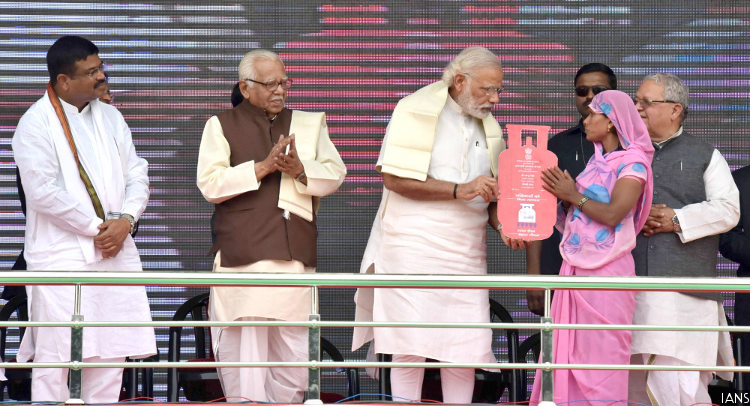Auditor Rejects Government Claims On LPG Savings, Affluent Hold On To Subsidy

Prime Minister Narendra Modi distributes free cooking gas connections to beneficiaries under Pradhan Mantri Ujjwala Yojana, during its launch in May 2016. The scheme aimed at increasing clean cooking gas use among the poor by subsidising cylinder purchases with savings resulting from the Give It Up campaign has progressed only half as much as official data suggest.
Prime Minister Narendra Modi’s claims on boosting clean fuel use among the poor with help from savings due to the affluent giving up liquefied petroleum gas (LPG) subsidy remain unverified even as the Comptroller and Auditor General (CAG), India’s official auditor, has rejected the savings claim.
While LPG consumption by poor households under the Pradhan Mantri Ujjawala Yojana (PMUY, or Prime MInister’s Light Up Scheme), which provides subsidised LPG to below poverty line (BPL) households, lags sale of new connections, savings from the PAHAL Direct Benefits Transfer for LPG (DBTL) Consumer Scheme, which encourages affluent consumers to give up LPG subsidy, are only half of what the government claimed.
While LPG connections grew by 16.2% year-on-year in 2016-17, LPG consumption grew by 9.8%, Mint reported on June 28, 2017.
Under the Ujjwala scheme, beneficiaries receive subsidy on their first cylinder in the form of a loan, which is to be repaid by paying for refills at the market price. Most BPL households cannot afford to pay the market rate and hence never come back to refill, gas agency dealers across Gujarat, Madhya Pradesh, Bihar, Jharkhand, Uttarakhand and Uttar Pradesh said, Scroll reported on June 11, 2017.
As many as 80% of beneficiaries take their second refill, Dharmendra Pradhan, minister of state in the petroleum and natural gas ministry, told the Rajya Sabha (upper house of Parliament) on July 26, 2017. The government has distributed 25 million LPG connections as of July 15, 2017 against a target of 50 million by 2018-19, according to official data.

Source: Petroleum Planning and Analysis Cell
Cheap oil, not PAHAL, behind savings
At Rs 4,813 crore, savings from the PAHAL scheme in 2015-16 were only half of the Rs 9,211 crore the petroleum and natural gas ministry had predicted, according to the CAG report.
Launched in November 2014, the PAHAL scheme encourages affluent consumers to give up their LPG subsidy, under the ‘Give It Up Scheme’, which is expected to fund the Rs 8,000 crore Ujjwala scheme.
Under the scheme, 181.8 million consumers who use domestic LPG are entitled to receive subsidy on 12 cylinders a year.
| Consumers Who Gave Up Cooking Gas Subsidy | |
|---|---|
| Month | Consumers |
| January 2015 | 22,000 |
| February 2016 | 6.727 million |
| January 2017 | 10.5 million |
Source: CAG Report, Indian Express
In January 2015, 22,000 consumers willingly gave up their LPG subsidy. In two years, the number of such consumers increased 500 times to 10.5 million in January 2017.
State-wise, Maharashtra has the highest number of consumers (1.73 million) who have voluntarily given up their LPG subsidy, followed by Uttar Pradesh (1.28 million) and Delhi (0.79 million), according to this February 2017 reply given to the Lok Sabha.
During April-December 2015, Rs 21,552 crore--92% of the Rs 23,316 crore the government saved year-on-year--was owing to cheaper crude oil prices, according to the CAG report. In 2015-16, only Rs 1,764 crore was saved due to the PAHAL and ‘Give it Up’ schemes compared to Rs 6,443 crore estimated by the government--slightly more than a fourth.
The Government estimates savings from PAHAL and the Give it Up campaign to be Rs 8,185 crore (Rs 1,357 crore under Give it Up), according to this July 2017 Rajya Sabha reply.
2 cylinders on every Aadhaar number
As many as 74,000 unique LPG consumer IDs were linked to only 37,000 Aadhaar numbers as of August 2015, according to the CAG report. Aadhaar was supposed to weed out fictitious claimants of subsidy.
Nearly 960,000 consumers not eligible under the PAHAL scheme received Rs 49.21 crore as permanent advances. Under the PAHAL scheme, a permanent advance is an amount that is paid to eligible domestic consumers to help them purchase their first LPG cylinder at the market price.
This implied funds otherwise meant for eligible consumers were blocked.
The LPG Control Order, 2000 allows each household a single LPG cooking gas connection under the public distribution system. Each LPG connection has a unique consumer ID linked to an Aadhaar number or a bank account (in case the person does not have an Aadhaar number).
(Nair is an intern with IndiaSpend and FactChecker.)


